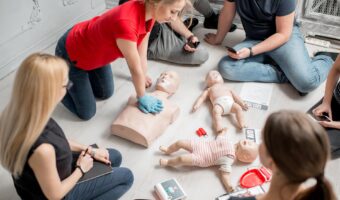FIRST AID, CPR & AED
About This Course
MindMerge first aid training classes give you the information and the skills you need to describe the procedures and practices involved with identification of a first aid emergency case, as well as best practices to administer aid, including CPR and the use of an AED.
Learning Objectives
Identify What to do Before Giving Care
Check an Injured Person
Identify What is CPR and When to Use It
Identify What is an AED and When to Use It
Identify Various Possible Emergencies
Physically be Able to Administer Proper First Aid
Identify How to Avoid Injuries
Target Audience
- Managers, Supervisors, and Safety Representatives
Curriculum
16h
Before Giving Care
•Preparing for Emergencies
•Understanding Your Role in the EMS System
•Obtaining Consent to Help
•Lowering the Risk for Infection
•Taking Action: The Emergency Action Steps
•Skill Check
•1-1: Removing Latex-Free Disposable Gloves 2
Checking an Injured or Ill Person
•Checking a responsive person.
•Checking a person who appears to be un-responsive.
•Skill Check
•2-1: Checking a responsive person.
•2-2: Checking a person who appears to be un-responsive.
Cardiac Emergencies
•Heart Attack
•Cardiac Arrest
•Giving CPR
•Using an AED
•Working as a Team
•Skill Check
•3-1: Giving CPR to an Adult
•3-2: Giving CPR to a Child
•3-3: Giving CPR to an Infant
•3-4: Using an AED
Choking
•Risk Factors for Choking
•Signs and Symptoms of Choking
•First Aid for Choking
•Skill Check
•4-1: Caring for an Adult Who Is Choking
•4-2: Caring for a Child Who Is Choking
•4-3: Caring for an Infant Who Is Choking
Sudden Illness
•General Approach to Sudden Illness
•Respiratory Distress
•Asthma
•Allergic Reactions & Anaphylaxis
•Diabetic Emergencies
•Seizures
•Fainting
•Stroke
•Skill Check
•5-1: Assisting with an Asthma Inhaler
•5-2: Assisting with an Epinephrine Auto Injector
Traumatic Injuries
•Shock
•Internal Bleeding AGENDA
•Wounds
•Burns
•Muscle, Bone, and Joint Injuries
•Head, Neck, and Spinal Injuries
•Nose and Mouth Injuries
•Chest Injuries
•Abdominal Injuries
•Pelvic Injuries
•Skill Check
•6-1: Using Direct Pressure to Control External Bleeding
•6-2: Using a Commercial Tourniquet
Environmental Injuries & Illnesses
•Exposure Injuries & Illnesses
•Poisoning
•Bites and Stings
•Rash Causing Plants
•Lightning Strike Injuries
•Head, Neck, and Spinal Injuries
•Nose and Mouth Injuries
•Chest Injuries
•Abdominal Injuries
•Pelvic Injuries
Emergency Moves
Special First Aid Situations
•
Abuse
•
Emergency Childbirth
Special Considerations for Signs and Symptoms in Children
•Fever
•Vomiting & Diarrhea
•Respiratory Distress
Injury Prevention
•General Strategies for Reducing the Risk of Injury
•Vehicle Safety
•Fire Safety
•Safety at Home
•Safety at Work
•Safety at Play






